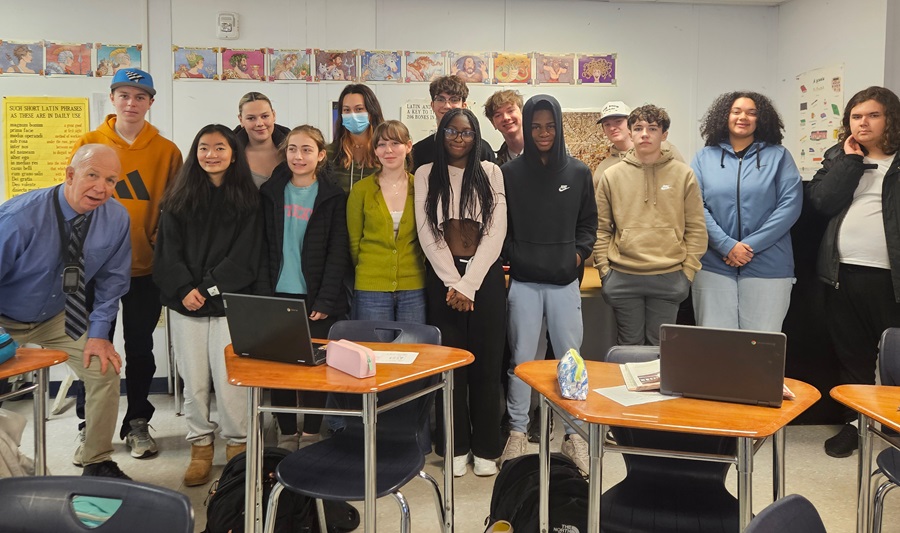EASTHAM — Skylar Baker, a Nauset Regional High School senior, is reading part of Ovid’s first-century magnum opus, Metamorphoses. It’s an enormous collection, but he’s focused on book one, the Roman poet’s retelling of the Greek transformation myth of Apollo and Daphne — in which Apollo’s lust is thwarted when the object of his desire becomes a tree.
Reading the story, though it’s only 65 lines long, is a weighty undertaking. Baker takes one phrase at a time, first working out the language itself, then, with help from his teacher and others in the class, rendering a preliminary literal translation. Then he goes back to work, interpreting that one phrase’s relationship to the rest of the piece. In this, as the ancient Romans said, ipse solus est: He is alone.
Once Baker is satisfied with his translation, he goes back and reads aloud from the original Latin text, focusing this time on the way the language sounds. It’s slow work, but it’s work Baker finds beautiful: “It’s art in the form of poetry,” he says. “It was written almost 2,000 years ago, and it’s amazing how we’re still able to read and understand it.”

This is Baker’s third year studying Latin at Nauset; he’s one of five students in a combined Latin III and IV class. He’s big into history, he says, which is one of the main reasons he chose the course. But although culture and history are inevitably part of what it’s about, he’s more and more absorbed in learning the language — which, since it is not the spoken language of any community, means delving into the translation of classical works.
“The rap against the language is that it isn’t practical,” says Nauset Latin teacher Sean Mulholland, “but the students it attracts aren’t so interested in practicality — they’re curious about how things came to be.”
Finding connections between ancient and modern life is an important part of studying Latin, Mulholland says. The 18 students in the school’s combined Latin I and II class are studying the life of Lucius Caecilius Iucundus, a Pompeiian banker who lived in the first century CE. Iucundus is the basis of the character called Caecilius in the Cambridge Latin Course textbook used at the school.
The portrayal of Caecilius’s family in the book sounds modern. His son, Quintus, and daughter, Lucia, are teenagers who attend school, go to the gym, complain about work, and are scolded by their parents.
Just before the winter holidays, the curriculum covered Saturnalia. While the Romans didn’t celebrate Christmas, Mulholland says, they had a late-December festival that included revelry, gambling, feasting, and gift-giving to honor Saturn, the Roman god of time. “So much of what we do is based on the ancient traditions,” Mulholland says. “Finding those connections over the ages makes the language all the more real for students who study it.”
Mulholland picked Ovid’s epic poetry of Metamorphoses for the Latin III and IV students because he thought they would find it relatable. “Given the literature’s focus on changes and transitions, I figured it would speak to them as high school seniors,” he says.
That seems to be the case. The seniors are creating a website called The Ovid Project, which will feature translations and analyses of the work as well as art influenced by it and recordings of students reading the poem in the original Latin.
Mulholland got his first exposure to the language from his father, a professor of Greek and Latin at Georgetown University, when he was a teenager. He got his degree in classics from the University of Virginia in 1987 and has been teaching Latin ever since. He moved to the Cape in 2000 and was the Latin teacher at Chatham Middle School before coming to Nauset in 2011.
A weeklong trip to Rome for students is a February tradition Mulholland started in 2014, and this year 15 students will go, but not all of them take Latin — it is open to all students. The trip isn’t run through the school — Mulholland organizes it independently. This year’s trip will cost participants $2,600.
Architecture is a big part of the experience. “You’re surrounded by all this architecture, built as far back as the 6th century BCE,” says Baker, who has been on the Rome trip twice. He won’t join this year’s group, but he says going helped him feel the immediacy of the language and culture he’d been learning at school.
Nauset’s student travelers will also be among the Vatican’s anticipated 35 million visitors in 2025. Mulholland takes students to St. Peter’s Square to hear the Pope deliver the weekly Angelus address in Latin.
Mulholland tells students that Latin is like the frame of a house: they might not see the frame, he says, but it’s there, and it’s holding up the walls. Latin is the framework of the English language, and Roman ideas form the basis for many European cultures.
“If you know how your house is put together,” he says, “you can take better care of it.”



